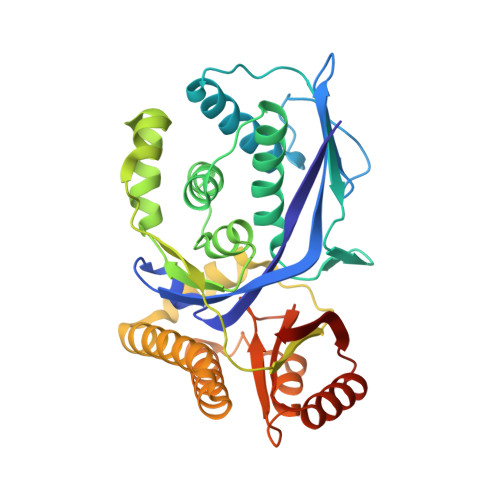Structure of the ternary complex of phosphomevalonate kinase: the enzyme and its family
Andreassi, J.L., Vetting, M.W., Bilder, P.W., Roderick, S.L., Leyh, T.S.(2009) Biochemistry 48: 6461-6468
- PubMed: 19485344
- DOI: https://doi.org/10.1021/bi900537u
- Primary Citation of Related Structures:
3GON - PubMed Abstract:
The galacto-, homoserine-, mevalonate-, phosphomevalonate-kinase (GHMP) superfamily encompases a wide-range of protein function. Three members of the family (mevalonate kinase, phosphomevalonate kinase, and diphosphomevalonate decarboxylase) comprise the mevalonate pathway found in S. pneumoniae and other organisms. We have determined the 1.9 A crystal structure of phosphomevalonate kinase (PMK) from S. pneumoniae in complex with phosphomevalonate and AMPPNP.Mg(2+). Comparison of the apo and ternary PMK structures suggests that ligand binding reverses the side-chain orientations of two antiparallel lysines residues (100 and 101) with the result that Lys101 is switched into a position in which its ammonium ion is in direct contact with the beta,gamma-bridging atom of the nucleotide, where it is expected to stabilize both the ground and transition states of the reaction. Analysis of all available GHMP kinase ternary complex structures reveals that while their C(alpha)-scaffolds are highly conserved, their substrates bind in one of two conformations, which appear to be either reactive or nonreactive. The active site of PMK seems spacious enough to accommodate interconversion of the reactive and nonreactive conformers. A substantial fraction of the PMK active site is occupied by ordered water, which clusters near the charged regions of the substrate. Notably, a water pentamer that interacts extensively with the reactive groups of both substrates was discovered at the active site.
- DuPont Crop Protection, Stine-Haskell Research Center, Newark, Delaware 19711, USA.
Organizational Affiliation:



















